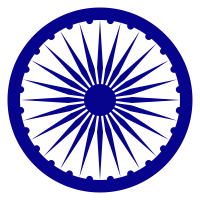

The Ashoka Chakra (Transl: Ashoka's wheel) is an Indian symbol which is a depiction of the dharmachakra (English: "wheel of dharma"). It is so-called because it appears on a number of edicts of Ashoka the Great,[1] most prominent among which is the Lion Capital of Ashoka.[2] The most visible use of the Ashoka Chakra today is at the centre of the Flag of India (adopted on 22 July 1947), where it is rendered in a navy blue colour on a white background, replacing the symbol of charkha (spinning wheel) of the pre-independence versions of the flag. It is also shown in the Ashoka Chakra medal, which is the highest award for gallantry in peacetime.
Symbolic history
[edit]When Gautama Buddha achieved enlightenment at Bodh Gaya, he came to Sarnath. There, he found his five disciples, Assaji, Mahānāman, Kondañña, Bhaddiya and Vappa, who had earlier abandoned him. He introduced his first teachings to them, thereby establishing the Dharmachakra. This is the motif taken up by Ashoka and portrayed on top of his pillars.
The 24 spokes represent the twelve causal links taught by the Buddha and paṭiccasamuppāda (Dependent Origination, Conditional Arising) in forward and then reverse order.[3] The first 12 spokes represent 12 stages of suffering. The next 12 spokes represent no cause no effect. So, due to awareness of the mind, the formation of mental conditioning stops. This process stops the process of birth and death, i.e. nibbāna. It also depicts the “wheel of time”. The twelve causal links, paired with their corresponding symbols, are:
- Avidyā ignorance
- Saṅkhāra conditioning of mind unknowingly
- Vijñāna not being conscious
- Nāmarūpa name and form (constituent elements of mental and physical existence)
- Ṣalāyatana six senses (eye, ear, nose, tongue, body, and mind)
- Sparśa contact
- Vedanā sensation
- Taṇhā thirst
- Upādāna grasping[4]
- Bhava coming to be
- Jāti birth
- Jarāmaraṇa old age[5] and death[6] – corpse being carried.
These 12 in forward and reverse represent a total 24 spokes representing the dharma. The Ashoka Chakra depicts the 24 principles that should be present in a human.
Inclusion in the national flag of India
[edit]Ashoka Chakra was included in the middle of the national flag of India. The chakra intends to show that there is life in movement and death in stagnation.[7][8] Originally, the Indian flag was based on the Swaraj flag, a flag of the Indian National Congress adopted by Mahatma Gandhi after making significant modifications to the design proposed by Pingali Venkayya.[9] This flag included charkha which was replaced with Ashoka Chakra by the proposal of Nehru.[10]
Construction Sheet
[edit]See also
[edit]Notes
[edit]- ^ Aryan, K. C. (1996). Encyclopaedia of Indian art, references, symbols & evolution of Devanagari script : Rekhā. Internet Archive. New Delhi : Rekha Prakashan. p. 115. ISBN 978-81-900003-4-5.
Dharma—Chakra (the Buddhist symbol) during the time of Ashoka the Great...
- ^ "The 'Lion Capital': a Buddhist symbol that became India's National Emblem". The Heritage Lab. 4 August 2019. Archived from the original on 10 August 2020. Retrieved 9 August 2020.
- ^ Maha Nayaka Thera, http://www.sundaytimes.lk/110710/Plus/plus_10.html Archived 27 June 2019 at the Wayback Machine, The correct use of the 'Dharmachakra'
- ^ See, for example, Rhys Davids & Stede (1921–25), p. 149; and, Gombrich (2005).
- ^ See Rhys Davids & Stede (1921–25), p. 279, entry for "Jarā", retrieved 19 November 2008 from "U. Chicago" at [1] . More than simply "old age", the PED provides the additional meanings of "decay, decrepitude"; and, these additional translations are reflected in the Buddha's reputed words in the Jarā Sutta (below). However, for the sake of semantic conciseness, the compound term jarā-maraṇa is here represented as "old age and death."
- ^ See Rhys Davids & Stede (1921–25), p. 524, entry for "Maraṇa", retrieved 19 November 2008 from "U. Chicago" at [2] . The PED further contextualizes maraṇa with "death, as ending this (visible) existence, physical death...." That is, in Buddhism, maraṇa does not refer to death of the conscious process or the end of the associated suffering.
- ^ "What is the meaning of 24 spokes of Ashok Chakra?". Jagranjosh.com. 13 August 2019. Archived from the original on 2 November 2020. Retrieved 9 August 2020.
- ^ "Independence Day Special: Evolution of the Indian flag". 15 August 2015. Archived from the original on 1 October 2020. Retrieved 21 September 2020.
- ^ Kapoor, P. (2018). Gandhi: An Illustrated Biography (in Maltese). Roli Books. p. 121. ISBN 978-81-936009-1-7. Retrieved 14 August 2023.
- ^ Goucher, C.; Walton, L. (2013). World History: Journeys from Past to Present. Taylor & Francis. p. 667. ISBN 978-1-135-08828-6.
